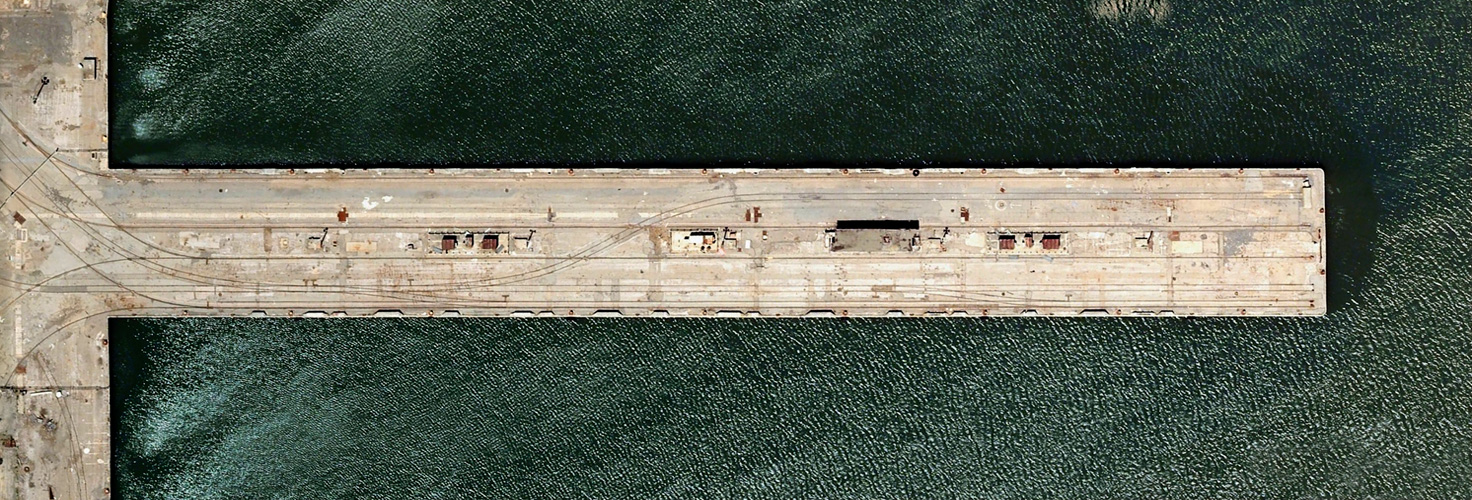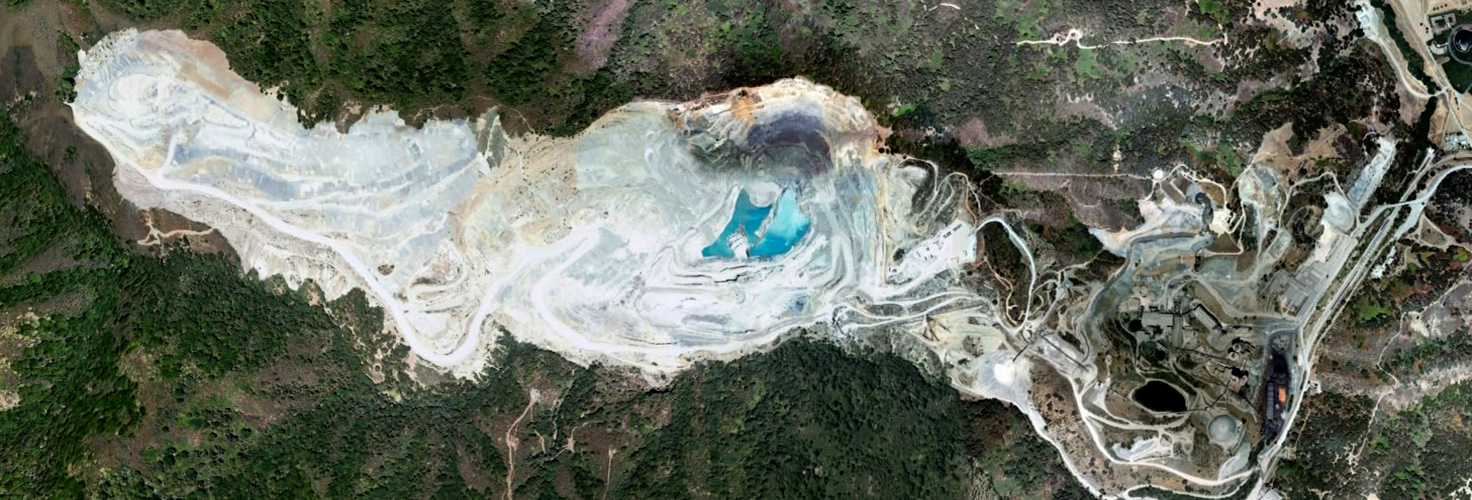San Francisco Wharf Complex - Geologic Analog/Research - Overview & Phase III Preliminary
Bernard Osher Fellowship - Exploratorium, San Francisco, CA 2008-09
Left: aerial view of the length of example pier, San Francisco Bay, CA - image cropped from Google Earth aerial.
Right: prototypical geologic origin for cement faction of San Francisco Wharf Complex concrete: aerial view of limestone quarry, Calera Formation,
Permanente Terrane, coast ranges near Cupertino, CA - image cropped from Google Earth aerial.
EXPLORATORIUM, SAN FRANCISCO- OSHER FELLOWSHIP OVERVIEW:
Summer 2008, a research fellowship with the Exploratorium funded by the Bernard Osher Foundation was initiated. This fellowship was preceded by other work with the Exploratorium in the form of a series of proposals for projects for Fort Mason, and its piers, as part of a National Science Foundation grant. The Fort Mason group of studies is part of the Felsic/Mafic/Carbonate Facies Series. Aspects of the work under the Osher Fellowship are planned as part of this group of investigations. The fellowship will fund research and devopment time primarily directed towards research of selected wharf and pier structures along the San Francisco Bay waterfront. In this regard, this complex assemblage of primarily concrete, steel along with wood structures, is being viewed and analyzed as anthropocene geologic formations, attempting to locate these structures within larger geologic and anthropocene cycles of denudation, deposition and transformation, with the research being proposed as consisting of four inter-related phases:
PHASE I – 3D CAD drawing of selected piers and seawall/shoreline history relating to current geology.
PHASE II – Video/Data stratigraphic scan visualization/analysis of selected piers.
PHASE III – Industrial archeo/geologic study of pier structure, tracing pier materials to their origins in the Bay Area landscape - initial elements shown on this page. In addition to the pier material's paleosites, data from Phase I, to be used to calculate the total material volume of selected pier structure's constituent elments: cement, aggregate, rebar, piling tree trucks, to arrive at qualitative and quanitative paleogeographic analogs and depositonal enviroment/terrain equivalents for each material.
PHASE IV – Tagging and tracking (electronic, radiological, data base, etc., - TBD) of removed pilings and pier materials in a series of planned transformations from current conditions – tracking and logging the new resting place (depositional environment) of “discarded” materials.
|
PRELIMINARY STUDY: SAN FRANCISCO WHARF COMPLEX- PHASE III
SAN FRANCISCO WHARF COMPLEX- PRELIMINARY GEOCHEMICAL ANALYSIS/PROVENANCE/PETROGENESIS
CALC-SILICATE CONGLOMERATE – Assorted clastics cemented in a complex calcium silicate matrix to form conglomeratic mass as dominate tectonic structures. Cement derived from Calcium carbonate (CaCO3) Anthropocene calcination at 1500 ºC at surface pressures to form CaO, CaCO or lime. Rehydrated in situ, clast laden slurry becomes massive .25 -1m thick horizontal and vertical beds, to 10 m + vertical penetration of contemporary and older sediments at bottom of sequence. Provenance and petrogenesis: Cement: probable local Cretaceous fossiliferous marine carbonates; Clasts: probable local Franciscan Complex or Great Valley Sequence derived gravels; integrated linear ferruginous structures: possible meta-continental natural and or recycled origin.
(Adapted from: SITE INDEX, Rhapson Group: Concrete, University of Minnesota, Minneapolis, MN, consulting geologist, Carrie Jennings, MN Geologic Survey, 2001-09).
SAN FRANCSCIO WHARF COMPLEX: PROTOTYPICAL/EXEMPLARY CEMENT CONSTITUENT ORIGIN
PERMANENTE TERRANE - Foraminiferal limestone (Upper and Lower Cretaceous)—Pelagic gray, gray-green, black, and pink, locally bituminous and (or) oolitic, foraminiferal limestone and minor black to gray, nodular to lenticular radiolarian chert. Foraminifers and sparse megafossils indicate that limestone formed at equatorial latitudes between the Late Cretaceous (Turonian) and the late Lower Cretaceous (Hauterivian). Limestone was deposited in shallow to deep water, open-ocean, seamount, and (or) oceanic plateau settings (Sliter and others, 1991). This seamount gradually moved from far to the south in the Pacific Ocean and became attached and exposed in the Santa Cruz Mountains by the gradual processes associated with plate tectonics.
(Adapted from: McLaughlin, R.J., Clark, J.C., Brabb, E.E., Helley, E.J., and Colón, C.J., Geologic maps and structure sections of the southwestern Santa Clara Valley and southern Santa Cruz Mountains, Santa Clara and Santa Cruz Counties, California, Pamphlet to accompany Miscellaneous Field Studies Map MF-2373, USGS, 2001; Sliter, W.V., Murchey, B.L., McLaughlin, R.J., and Kistler, R.W., Permanente Terrane: History of Early Cretaceous seamount formation in the eastern Pacific [abs.]: Geological Society of America Abstracts with Programs, v. 23, p. 98. 1991, and Tarduno, J.A., McWilliams, M., Debiche, M.G., Sliter, W.V., and Blake, M.C., Franciscan Complex Calera Limestones: Accreted Remnants of Farallon Plate Oceanic Plateaus, Nature, 317, 345-347, 1985).
The Permanente quarry has been in operation for nearly 60 years and claims to supply about one-third of Northern California's cement. Hanson purchased the plant from Kaiser in 1987.
|
Adapted from various geotechical and geologic reports by Treadwell & Rollo and engineering reports by Rutherford& Chekene, both of San Francsco, CA, Norfleet Consultants, Livermore, CA, Trask and Rolston, GSA Bulletin 62, Sloan,
GSA Bulletin 104, NOAA bathymetric maps and historical drawings from the Port of San Francisco Board of State Harbor Commissioners, Department of Engineering, all information subject to further, professional verification.
Related SFWC Projects
Pier 15-17 Complex Phase II
San Francisco Wharf Complex / Sym.bi.osis
Passage: Displaced Sea/Seeking the Permanente
Return to: Recent Projects
|

